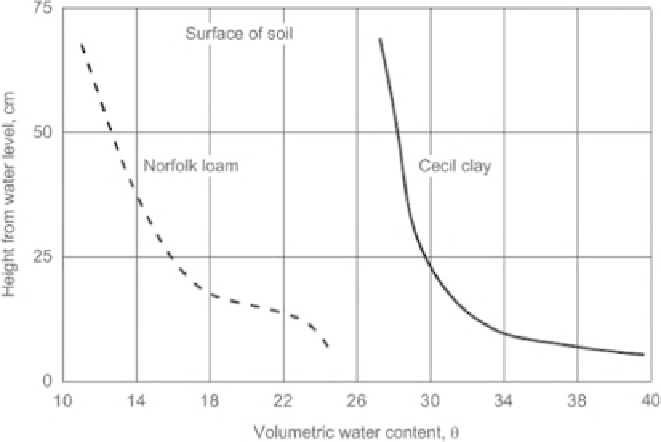Environmental Engineering Reference
In-Depth Information
The chemical potentials could also produce independent
processes.
The contributions of soil physics have been of significant
value in the development of unsaturated soil mechanics. It
has also been necessary to ensure that the successful con-
textual framework for saturated soil mechanics be retained
when embracing unsaturated soil behavior. In general, a
parallelism between saturated soil mechanics and unsatu-
rated soil mechanics has been maintained. Unsaturated soil
mechanics is largely taught as an extension of the concepts
fundamental to saturated soil mechanics. The SWCC has
played an important role in extending saturated soil mechan-
ics to embrace unsaturated soil behavior.
Haines (1930) used a Buchner funnel with a high-air-entry
disk sealed in the base of the funnel to measure the SWCC.
A tensile stress was applied to the underlying water reservoir
and the soil was allowed to come to equilibrium with the
applied negative water pressure. The maximum tensile stress
that could be applied to the soil-water was somewhat less
than 1 atm.
Valle-Rodas (1944) performed open-tube and capillarime-
ter tests on uniform sands. Various sand particle size ranges
were separated using sieves. Each material with a limited
range of grain sizes was placed in the open tube and the
capillarimeter. The bottom end of the sand in the open
tube was immersed in water. Experimental results showed
a gradual change in the water content in the sand with dis-
tance above the water reservoir (Fig. 5.2). Further tests were
performed that illustrated hysteretic behavoir in the water
content versus matric suction relationship during wetting
and drying. Other open-tube and capillarimeter tests were
also performed on cohesionless soils ranging from silt sizes
to gravel sizes by Lane and Washburn (1946).
Richards (1928) also allowed soil samples to establish
equilibrium water content conditions with the water vapor
above a saturated salt solution (i.e., a fixed relative humidity
environment). The vapor pressures established above the salt
solutions could be computed using the Lord Kelvin energy
equation.
5.1.3 Early Equipment for Measuring the SWCC
Buckingham (1907) measured SWCCs for a variety of soils.
Long cylinders were filled with soil and water was allowed
to come to equilibrium with a water reservoir at the base of
the column. The gravitational potential energy within each
column of soil was calculated based on the distance above
the free-water surface in the reservoir and was referred to as
the “capillary potential.” Figure 5.1 shows two SWCCs plot-
ted as continuous functional relationships between capillary
potential and water content.
Richards (1928) placed thin soil specimens on a high-
air-entry ceramic disk that was connected to an underlying
water reservoir. A vacuum tank was used to place the water
in the underlying water reservoir under tension. The soil
specimens were subjected to a negative water pressure head
until equilibrium was established between the soil and the
pressure in the water reservoir. The water content of the soil
was measured once equilibrium conditions were established.
The equipment became known as the
Richards pressure plate
apparatus (Richards, 1928).
5.1.4 Early Conceptual Models of Flow
in Unsaturated Soils
In 1931 Richards derived a water flow equation for unsatu-
rated soils. The flow equation was based on capillary con-
duction and water storage was assumed to be a function of
capillary potential. Capillary potential was perceived to be
equivalent to the negative pore-water pressure in the soil.
Figure 5.1
Early measurements of water content versus matric suction on two soils (after
Buckingham, 1907).










Search WWH ::

Custom Search